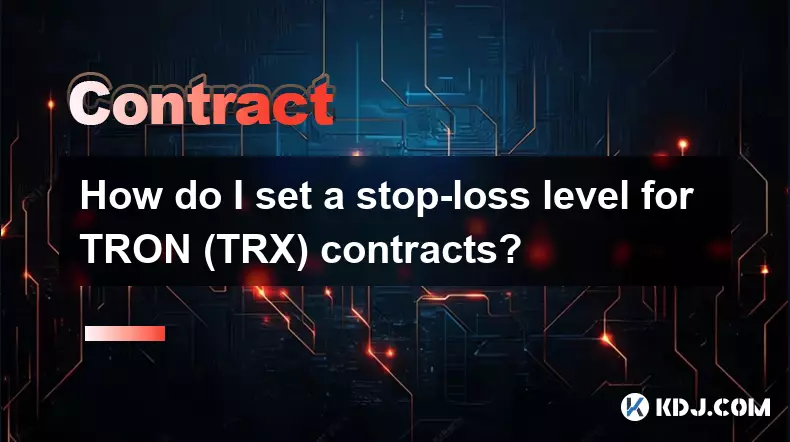-
 bitcoin
bitcoin $122090.672462 USD
1.59% -
 ethereum
ethereum $4493.758974 USD
0.56% -
 xrp
xrp $3.033145 USD
0.65% -
 tether
tether $1.000629 USD
0.00% -
 bnb
bnb $1169.854250 USD
7.07% -
 solana
solana $230.954786 USD
-0.19% -
 usd-coin
usd-coin $0.999785 USD
0.00% -
 dogecoin
dogecoin $0.256108 USD
-1.12% -
 tron
tron $0.342333 USD
-0.12% -
 cardano
cardano $0.859632 USD
-0.10% -
 hyperliquid
hyperliquid $48.932146 USD
-2.25% -
 chainlink
chainlink $22.345466 USD
-1.29% -
 ethena-usde
ethena-usde $1.000217 USD
-0.03% -
 avalanche
avalanche $31.203456 USD
1.93% -
 sui
sui $3.579145 USD
1.05%
How do I set a stop-loss level for TRON (TRX) contracts?
A stop-loss in TRON (TRX) futures helps limit losses by automatically exiting trades if the price moves against you, protecting capital from sudden volatility.
Sep 29, 2025 at 07:18 am

Understanding Stop-Loss in TRON (TRX) Futures Trading
1. A stop-loss order is a risk management tool used to limit potential losses on a trading position. In the context of TRON (TRX) futures contracts, setting a stop-loss helps traders exit a trade automatically when the price moves against their position beyond a predetermined level. This mechanism protects capital from significant downside movements caused by sudden market volatility or unexpected news.
2. Futures contracts for TRX are traded on various cryptocurrency derivatives exchanges such as Binance, Bybit, and OKX. These platforms allow traders to go long or short with leverage, increasing both profit potential and risk exposure. Because leveraged positions can lead to rapid liquidation if not monitored closely, implementing a well-calculated stop-loss becomes essential.
3. The placement of a stop-loss should not be arbitrary. It must consider technical levels, recent price action, and the overall market structure. For instance, placing a stop-loss just below a strong support zone makes more sense than choosing a random price point. Traders often analyze candlestick patterns, moving averages, and volume indicators to determine logical exit points.
4. Volatility plays a crucial role in determining stop-loss distance. TRX, while less volatile than some altcoins, still experiences sharp swings during major network updates or macroeconomic events. Setting the stop too close to the entry price may result in being stopped out prematurely due to normal market noise.
5. Different types of stop-loss orders exist—such as market stop-loss and stop-limit orders. A market stop-loss executes at the best available price once triggered, ensuring exit but potentially at a worse rate during fast-moving markets. A stop-limit provides more control but risks non-execution if liquidity dries up.
Key Factors Influencing Stop-Loss Placement for TRX
1. Technical analysis forms the backbone of effective stop-loss positioning. Identifying key support and resistance zones using horizontal lines, Fibonacci retracements, or trendlines allows traders to set stops just beyond these levels. If long on TRX, the stop-loss might be placed slightly below a recent swing low; for short positions, it would sit above a recent swing high.
2. Average True Range (ATR) is another useful metric. By measuring average price movement over a set period, ATR helps define a dynamic stop-loss that adjusts to current volatility. For example, a multiple of the 14-period ATR added to or subtracted from the entry price creates a buffer that accounts for normal fluctuations.
3. Position size and leverage directly affect how wide or tight a stop-loss can be. High leverage reduces the margin buffer, meaning even small adverse moves can trigger liquidation. Adjusting position size relative to stop distance ensures that the account can withstand expected drawdowns without full loss.
4. Market context matters. During periods of low volume or consolidation, tighter stops may work. However, around major announcements like protocol upgrades or exchange listings, wider stops are advisable to avoid getting shaken out by temporary spikes.
5. Some traders use psychological price levels—like round numbers ($0.100, $0.150)—as reference points. While these aren’t always reliable, they often attract algorithmic activity and can serve as meaningful barriers where reversals or breakouts occur.
Practical Steps to Set a Stop-Loss on TRX Contracts
1. Begin by defining your trading strategy and time frame. Day traders may rely on 5-minute or 15-minute charts, whereas swing traders look at 4-hour or daily structures. The chart interval influences how precise your stop placement needs to be.
2. After identifying an entry point based on your strategy, locate the nearest technical invalidation level. If buying TRX futures after a bullish engulfing pattern at $0.12, the stop could be placed at $0.115, just under the prior low, indicating the setup has failed.
3. Calculate your risk per trade. Most professional traders risk no more than 1-2% of their trading capital on a single position. Use this percentage to determine whether your chosen stop distance requires adjusting your position size accordingly.
4. Enter the stop-loss order directly on the exchange platform. On most derivatives interfaces, you’ll see fields for “Stop Market” or “Stop Limit.” Input the trigger price and, if applicable, the limit price. Confirm the order before executing the trade.
5. Monitor open positions actively, especially during high-impact events. Even with a stop-loss in place, extreme slippage can occur. Consider using take-profit targets alongside stops to lock in gains and maintain a favorable risk-reward ratio.
Frequently Asked Questions
What is the difference between a stop-loss and a liquidation price in TRX futures?The stop-loss is an order set by the trader to exit at a specific price to limit losses. The liquidation price is determined by the exchange and represents the price at which the position is forcibly closed due to insufficient margin. They are separate mechanisms—one is user-controlled, the other system-enforced.
Can I modify my stop-loss after entering a TRX futures position?Yes, most exchanges allow traders to adjust or cancel stop-loss orders while the position remains open. Traders often move their stop-loss to breakeven or trail it upward as the market moves favorably to protect profits.
Should I use the same stop-loss strategy for all TRX trading sessions?No, market conditions vary significantly between sessions. Overnight trading may have lower liquidity, requiring wider stops. High-volume periods following news events demand more caution and possibly larger buffers to avoid premature triggering.
Is it safe to rely solely on stop-loss orders in volatile markets?While stop-loss orders are valuable tools, they do not guarantee execution at the desired price during flash crashes or extreme volatility. Gaps and slippage can result in fills far worse than anticipated. Combining them with proper position sizing and real-time monitoring enhances safety.
Disclaimer:info@kdj.com
The information provided is not trading advice. kdj.com does not assume any responsibility for any investments made based on the information provided in this article. Cryptocurrencies are highly volatile and it is highly recommended that you invest with caution after thorough research!
If you believe that the content used on this website infringes your copyright, please contact us immediately (info@kdj.com) and we will delete it promptly.
- BlockDAG, DOGE, HYPE Sponsorship: Crypto Trends Shaping 2025
- 2025-10-01 00:25:13
- Deutsche Börse and Circle: A StableCoin Adoption Powerhouse in Europe
- 2025-10-01 00:25:13
- BlockDAG's Presale Buzz: Is It the Crypto to Watch in October 2025?
- 2025-10-01 00:30:13
- Bitcoin, Crypto, and IQ: When Genius Meets Digital Gold?
- 2025-10-01 00:30:13
- Stablecoins, American Innovation, and Wallet Tokens: The Next Frontier
- 2025-10-01 00:35:12
- NBU, Coins, and Crypto in Ukraine: A New Yorker's Take
- 2025-10-01 00:45:14
Related knowledge

What is the difference between futures and perpetual contracts for Bitcoin?
Oct 02,2025 at 11:54pm
Understanding Bitcoin Futures Contracts1. Bitcoin futures are derivative instruments that allow traders to speculate on the future price of Bitcoin at...

What is the best time to trade PEPE contracts?
Oct 03,2025 at 11:54am
Understanding PEPE Contract Volatility1. PEPE contracts exhibit extreme price fluctuations due to their meme-based nature and low market cap. Trading ...

What are the common mistakes to avoid with Bitcoincoin contracts?
Oct 03,2025 at 08:54am
Emerging Trends in the Cryptocurrency Market1. Decentralized finance (DeFi) platforms continue to expand their influence across the blockchain ecosyst...

What is the maintenance margin for Bitcoin contracts?
Oct 02,2025 at 01:36am
Decentralized Exchanges Gain Momentum in 20241. Decentralized exchanges (DEXs) have seen a significant rise in trading volume, surpassing centralized ...

How to use technical analysis for trading XRP contracts?
Oct 03,2025 at 01:18pm
Understanding Price Patterns in XRP Futures1. Identifying chart patterns such as triangles, head and shoulders, and double tops or bottoms can provide...

What does "longing" PEPE contracts mean?
Oct 03,2025 at 11:54pm
Understanding Decentralized Exchanges in the Crypto Ecosystem1. Decentralized exchanges (DEXs) operate without a central authority, allowing users to ...

What is the difference between futures and perpetual contracts for Bitcoin?
Oct 02,2025 at 11:54pm
Understanding Bitcoin Futures Contracts1. Bitcoin futures are derivative instruments that allow traders to speculate on the future price of Bitcoin at...

What is the best time to trade PEPE contracts?
Oct 03,2025 at 11:54am
Understanding PEPE Contract Volatility1. PEPE contracts exhibit extreme price fluctuations due to their meme-based nature and low market cap. Trading ...

What are the common mistakes to avoid with Bitcoincoin contracts?
Oct 03,2025 at 08:54am
Emerging Trends in the Cryptocurrency Market1. Decentralized finance (DeFi) platforms continue to expand their influence across the blockchain ecosyst...

What is the maintenance margin for Bitcoin contracts?
Oct 02,2025 at 01:36am
Decentralized Exchanges Gain Momentum in 20241. Decentralized exchanges (DEXs) have seen a significant rise in trading volume, surpassing centralized ...

How to use technical analysis for trading XRP contracts?
Oct 03,2025 at 01:18pm
Understanding Price Patterns in XRP Futures1. Identifying chart patterns such as triangles, head and shoulders, and double tops or bottoms can provide...

What does "longing" PEPE contracts mean?
Oct 03,2025 at 11:54pm
Understanding Decentralized Exchanges in the Crypto Ecosystem1. Decentralized exchanges (DEXs) operate without a central authority, allowing users to ...
See all articles










































































